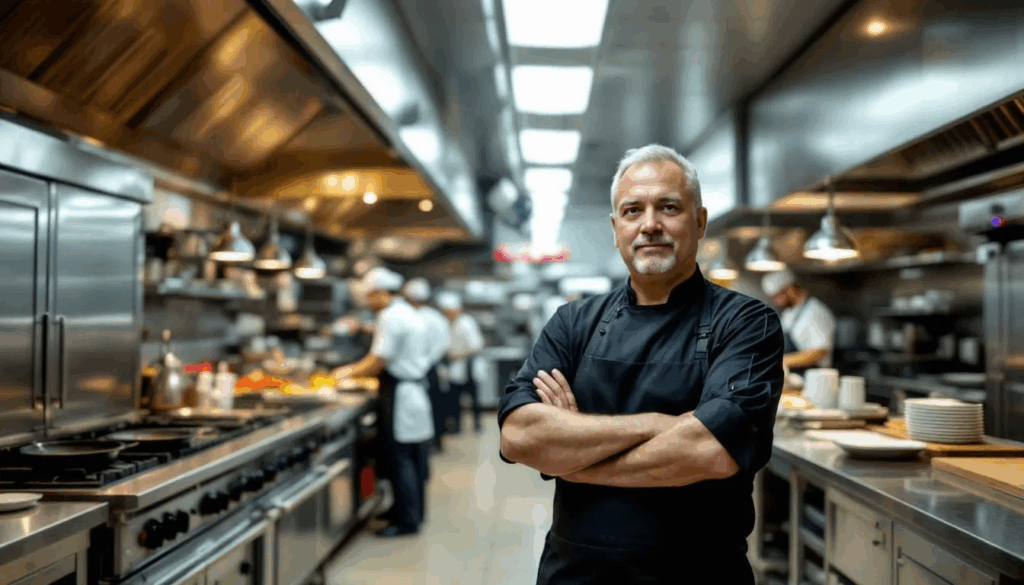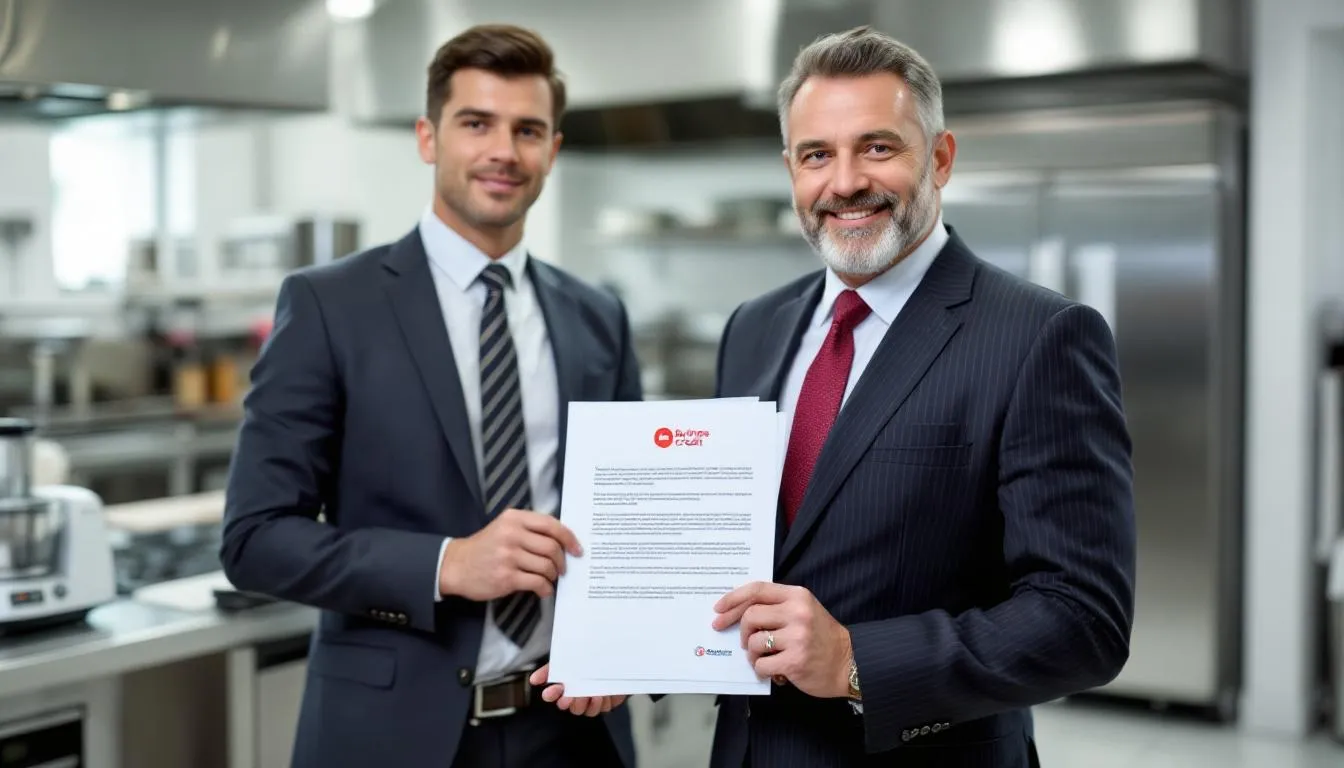What is Restaurant Equipment Financing?
Equipment financing allows business owners to purchase restaurant equipment on credit rather than paying the full amount upfront.
Most equipment financing loans are term loans with repayment periods ranging from three to five years. Interest rates for restaurant equipment loans can vary greatly, typically ranging from around 4% to 30%.
Many restaurant financing solutions allow you to acquire new or used equipment. Using financing enables restaurant owners to preserve working capital, allowing for better cash flow management and covering operating expenses.
The advantage of equipment financing is that you don’t have to wait to get the new equipment. Additionally, paying for it in installments allows you to maintain a steady cash flow and avoid depleting a significant amount of capital at once.
How does Restaurant Equipment Financing work?
You’re ready to expand your kitchen with a new commercial oven. Or, perhaps, you need to replace your industrial freezer. You shop around and find the piece or pieces you need from a vendor, it’s a good market value, and you already know how it will help you boost revenue.
But you don’t have the working capital to afford it. Perhaps you have enough cash reserved, and you don’t want to burn it. It’s always a good idea to keep money on hand for emergencies or slow periods.
So, you get your invoice for the new equipment. Now, you must find a lender or lending marketplace for your loan. Once you know that, you apply for the loan, including the invoice.
If approved, the lender sends the funds to the vendor to pay the invoice. The new equipment is then delivered and installed, allowing you to use it immediately. The lender holds a lien on the title to your equipment.
As you make payments, you build equity in the equipment, and restaurant owners can also use that equity for future financing. You pay off the loan in fixed monthly payments for the loan term. Once you finish paying off the loan, the lender releases the title in your name, and you own it outright.
There are several options for equipment financing. Let’s look at what’s available to the restaurant industry.
Equipment Loans
Restaurant equipment loans are like traditional loans. You receive a large sum upfront for the equipment purchase and then repay it in fixed monthly payments. Equipment financing loans can cover anywhere from 80% to almost 100% of the equipment cost.
The unique feature of an equipment loan is that the equipment, or asset, is the collateral. This is known as a self-collateralized loan. You may be familiar with other self-collateralized loans, such as car loans or mortgages.
Lenders face less risk since the collateral is part of the loan. The lower risk means lenders offer larger borrowing amounts at lower interest rates and longer repayment terms.
A qualified borrower could potentially get the following:
-
Up to $5 million per piece of restaurant equipment.
-
Loan terms are between 1 and 6 years.
-
Interest rates start at 3.5%.
-
Funding in 3-10 business days.
Other Small Business Loans
In addition to equipment loans, you could use several restaurant business loan options to finance equipment or other business expenses. Choosing the right loan depends on your specific needs. For example, equipment loan funds go directly to the vendor, but different loan types put the funds into your account.
You should be aware that one drawback is that they typically have lower borrowing amounts and stricter qualification requirements. Even so, you can use small business financing solutions to support cash flow or grow other areas of your restaurant.
Let’s look at some other small business loan options:
Restaurant Equipment Leasing
Leasing restaurant equipment is a form of long-term rental where the leasing company owns the equipment and allows you to use it for a set period. At the end of the lease, you return the equipment.
Some leasing companies will give you the option to purchase when the lease expires. You could also lease new restaurant equipment.
Lease payments tend to be lower than loan payment options. Restaurant equipment leasing is a good option for items that you don’t plan to use long-term.
The drawback is that you don’t own the equipment and can’t build equity with it. There are restaurant equipment leasing companies that offer this type of financing.
Who provides Restaurant Equipment Financing?
Many lenders offer equipment financing with flexible terms that can reach up to ten years. Let’s examine some lender options for financing restaurant equipment.
Traditional Banks
Some traditional banks offer equipment financing. If you can get approved, they typically offer the lowest interest rates. The problem is that most bank loan options have strict approval requirements.
You will need substantial revenue, an excellent credit score, and extended business history for approval. Some might even require additional business assets, a down payment, or a personal guarantee.
Alternative Lenders & Lending Marketplaces
Online lenders and lending marketplaces are gaining popularity among restaurants and other small businesses. Most are more agile in funding options so that they can find you loans, even the big ones that can’t. That means you won’t need as high a credit score. Online lenders often provide more accessible financing options compared to traditional banks for restaurant equipment.
Non-bank lenders and lending platforms offer loan products that are easier to qualify for and provide faster funding. A word of caution, though: not all online lenders are the same. Many are reputable and legitimate businesses, but some are just trying to make a quick buck.
When you work with an online lender or marketplace, look for one that offers transparency and has excellent online reviews. You need to trust your lending partner, and it helps to know other small businesses trust them. Be sure to look around at different lenders before signing an equipment finance agreement.
How do you qualify for Restaurant Equipment Financing?
The first step in pursuing restaurant equipment financing is finding a vendor for the equipment. Once you have your vendor, you must apply for an equipment loan.
Let’s review the process for obtaining a restaurant equipment loan.
Restaurant Equipment Loan Qualifications
Every lender has different qualifications. Some are upfront about their requirements, while others don’t tell you until after you apply. Most lenders consider your credit history, time in business, and annual gross sales.
To qualify for a restaurant equipment loan through United Capital Source, you will typically need the following:
-
A minimum credit score of 600.
-
At least 1 year in business.
-
Annual revenue of $250,000+.
What are the benefits of Restaurant Equipment Financing?
Restaurant equipment financing offers a practical solution for restaurateurs aiming to acquire essential equipment without depleting their capital. By spreading the cost over time, it preserves cash flow for other operational needs, such as payroll and inventory.
This approach often comes with flexible payment options and potential tax benefits, such as deductions under Section 179 of the Internal Revenue Code. Additionally, since the equipment itself serves as collateral, securing financing can be more accessible, even for businesses with limited credit history.
What are the drawbacks of Restaurant Equipment Financing?
Despite its advantages, restaurant equipment financing has drawbacks. Interest rates can be higher than those of traditional loans, especially for individuals with lower credit scores. There is also the risk that the equipment may become obsolete before the loan is repaid, potentially necessitating additional investments. Furthermore, funds obtained through equipment financing are typically restricted to equipment purchases, limiting flexibility for other business expenses.
Restaurant Equipment Financing Pros & Cons
Pros:
-
Preserves cash flow by spreading costs over time
-
Flexible payment options tailored to business needs
-
Potential tax benefits, such as Section 179 deductions
-
Easier approval due to the equipment serving as collateral
-
Quick access to the necessary equipment
Cons:
-
Potentially higher interest rates compared to traditional loans
-
Risk of equipment obsolescence before loan maturity
-
Funds are typically restricted to equipment purchases
-
Possible long-term financial
How to Apply for a Restaurant Equipment Loan:
Follow these steps to apply with United Capital Source.
Step 1: Ensure that buying equipment is the right choice for your restaurant.
You want to make sure the purchase price of the equipment is worth the cost of the loan. Some key considerations include the projected lifetime value of the new equipment and its ability to handle the job effectively.
Step 2: Gather your documentation.
You need to provide the following:
-
Driver’s license.
-
The invoice for the restaurant equipment.
-
Voided check from your business checking account.
-
Bank statements from the past three months to demonstrate cash flow.
-
Financial statements.
Step 3: Complete the application.
The application process is relatively fast, and you can apply directly through our one-page application in a matter of minutes or reach out to one of our loan experts to guide you through the process.
Step 4: Speak to a representative.
After we receive your application, a senior account executive will contact you. The account executive will discuss your needs and provide you with tailored restaurant equipment loan offers. We offer complete transparency, with no hidden fees or surprises.
You’ll get a complete breakdown of loan amounts, terms, and fees. Once you have all the information, you can decide which options make the most sense for your restaurant business.
Step 5: Get approved.
Your loan is approved when your application meets the underwriting requirements and receives final approval. Next, the funds are transferred directly to the seller to cover the invoice. We can help you set up automatic monthly payments, or you can arrange to pay by check or electronic payment.
Frequently Asked Questions
Here are some of the most common questions about restaurant equipment financing.
What kinds of Restaurant Equipment can I finance?
With high borrowing amounts, equipment loans allow you to finance a wide range of restaurant equipment. The key is to ensure that it serves a genuine business purpose. For example, replacing old equipment can help increase food safety. Many restaurant owners use equipment financing to upgrade to industry-leading commercial kitchen equipment.
Examples of commercial kitchen equipment you can finance include:
-
Commercial ovens
-
Electric stoves and gas ranges
-
Deep fryers
-
Industrial freezers
-
Walk-in fridges
-
Dishwasher equipment (sanitizers, dish racks, etc.)
-
Catering equipment
-
Cutlery and flatware
-
Food processors and stand mixers
-
Slicers
-
Safety equipment
-
Soda dispensers
-
Bar equipment
There are numerous equipment options beyond those listed above. You can also finance equipment related to your business that isn’t necessarily kitchen-specific, such as construction equipment.
For example, let’s say you are a catering business or offer catering services. You could also finance the catering delivery van (or vans) with a business auto equipment loan.
Is it better to finance or Lease Restaurant Equipment?
The decision to finance or lease restaurant equipment ultimately comes down to your specific business needs and the type of equipment itself. Leasing equipment makes more sense for short-term use, and a loan makes more sense for pieces you intend to use for a long time.
When you lease equipment, you don’t own it, so it’s something you can easily let go of or replace. Most commercial kitchen equipment has an extended lifetime, but there might be times when leasing makes more sense.
A lease could be a better option for newer restaurant owners who might not qualify for a loan. Lease payments are typically a lower monthly payment, but could end up being more than financing by the end of the lease.
Restaurant Equipment Financing vs. Leasing
|
Feature |
Leasing |
Financing (Loan) |
|---|---|---|
|
Ownership |
You do not own the equipment |
You own the equipment after loan repayment |
|
Best For |
Short-term equipment needs or items that may become outdated |
Long-term use of equipment with an extended lifetime |
|
Monthly Payments |
Typically lower monthly payments |
Monthly payments may be higher |
|
Total Cost Over Time |
Higher overall cost if lease runs full term |
Lower total cost if you use the equipment long term |
|
Ideal User |
Newer restaurants or owners don’t qualify for a loan |
Established restaurants with strong credit and financials |
|
Credit Requirements |
Generally more flexible requirements |
May require higher credit scores and business history |
|
Asset Value |
No equity—equipment must be returned or bought out |
Builds equity as you pay off the loan |
|
Flexibility |
Easier to upgrade or switch equipment |
Less flexibility once you purchase |
Can I get Restaurant Equipment Financing with Bad Credit?
Securing restaurant equipment financing with bad credit is possible, mainly when the equipment itself acts as collateral. Lenders understand that restaurants need reliable tools to operate and grow, so they often offer more flexible qualification criteria compared to traditional business loans. While a higher credit score can help secure better terms, it’s not always a deal-breaker for approval.
Some lenders may not require a minimum credit score to qualify for equipment financing if the business has been in operation for a specified period. In these cases, consistent revenue and time in business may carry more weight than your credit profile. This flexibility makes equipment financing a viable solution for newer restaurants or owners seeking to rebuild their credit.
Keep in mind that bad credit may result in higher interest rates or require a larger down payment. However, by making timely payments, this type of financing can also help improve your credit over time.
The only product listed above that isn’t available with bad credit is the Small Business Administration (SBA) Loan.
Restaurant Equipment Financing: Final Thoughts
As a restaurant owner, you want to provide high-quality meals that keep customers coming back. Many of your business efforts are devoted to crafting the perfect menu, marketing, managing staff, and creating a great atmosphere.
Restaurant equipment is essential in your efforts, but the full purchase price is often out of reach. There are various restaurant equipment financing options to consider. The equipment loan is advantageous because it’s easier to qualify for and can finance most necessary equipment.
When selecting a business lender or marketplace, look for one that offers transparency and excellent customer service. If you want to learn about your restaurant equipment loan options, you can apply now or reach out to one of our loan experts, who can answer any questions.















